JESD204C
Foreword
1 Scope
2 Normative references
3 Terminology
3.1 Terms and definitions
3.2 Symbols and abbreviated terms
4 Introduction and common requirements
4.1 Application overview
4.1.1 Background
4.1.2 Physical layer overview
4.1.3 Transport and link layer overview
4.1.3.1 Data encoding and organization
4.1.3.2 Clocking
4.1.3.3 Sync header stream
4.1.3.4 Deterministic latency
4.1.4 Data link properties
4.1.4.1 Variants and modes
4.1.5 Configuration examples
4.1.5.1 General
4.1.5.2 Single-device ADC application
4.1.5.3 Single-device DAC application
4.2 Deterministic latency
4.2.1 Introduction and general requirements
4.2.2 No support for deterministic latency (device subclass 0 and device subclass 1 using MULTIREF)
4.2.3 Deterministic latency using SYSREF (device subclass 1)
4.2.4 Deterministic latency using SYNC~ detection (device subclass 2)
4.3 Physical timing
4.3.1 Device clock
4.3.2 Link layer clock
4.3.3 Transport layer clock
4.3.4 Local multiframe and extended multiblock clocks (LMFC and LEMC)
4.3.5 SYSREF signal (device Subclass 1)
4.3.6 MULTIREF signal (device subclass 1)
4.3.7 SYNC~ generation and detection clocks (8B/10B link layer)
4.3.8 Skew and latency variation budget
4.4 Control interfaces
4.5 Device classification
4.5.1 Classes
4.5.2 Device subclassification
4.5.3 Features to be declared
5 Physical layer specification
5.1 Category B physical layer specification
5.1.1 Electrical specification overview
5.1.2 Compliance types
5.1.3 Transmission medium
5.1.3.1 Transmission medium insertion loss
5.1.4 Class B-3 ( LV-OIF-SxI5)
5.1.4.1 Compliance
5.1.4.2 Transmitter
5.1.4.3 Receiver
5.1.5 Class B-6 (LV-OIF-6G-SR)
5.1.5.1 Compliance
5.1.5.2 Transmitter
5.1.5.3 Receiver
5.1.6 Class B-12 (LV-OIF-11G-SR)
5.1.6.1 Applicability above 11.1 Gbps
5.1.6.2 Compliance
5.1.6.3 Transmitter
5.1.6.4 Receiver
5.2 Category C physical layer specification
5.2.1 Overview
5.2.2 Common transmitter electrical specifications
5.2.3 Common receiver electrical specifications
5.2.4 Common JESD204C channel operation margin (JCOM) parameters
5.2.5 Class C-S
5.2.6 Class C-M
5.2.7 Class C-R
5.2.8 Reference channels
5.2.9 Compliance
5.2.9.1 Transmitter
5.2.9.1.1 Device compliance
5.2.9.1.2 Model compliance
5.2.9.2 Receiver
5.2.9.2.1 Device compliance
5.2.9.2.2 Model compliance
5.2.9.3 Channel
5.2.9.4 Isolation
5.2.10 Transmitter definitions
5.2.10.1 Transmitter test fixture
5.2.10.2 Signaling rate and range
5.2.10.3 Signaling levels
5.2.10.4 Transmitter transition (rise/fall) time
5.2.10.5 Transmitter output return loss
5.2.10.6 Transmitter output waveform
5.2.10.7 Transmitter output noise and distortion
5.2.10.8 Waveform acquisition
5.2.10.9 Test pattern
5.2.10.10 Linear fit to the waveform measured at TP0a
5.2.10.11 Removal of the transfer function between the transmit function and TP0a
5.2.10.12 Transmitter output jitter
5.2.10.12.1 Even-odd jitter (DCD)
5.2.10.12.2 Effective bounded uncorrelated jitter (EBUJ) and effective random jitter (ERJ)
5.2.11 Receiver definitions
5.2.11.1 Receiver test fixture
5.2.11.2 Signaling rate and range
5.2.11.3 Signaling levels
5.2.11.4 Receiver input return loss
5.2.11.5 Receiver sensitivity
5.2.11.6 Receiver jitter tolerance
5.2.12 JESD204C channel operation margin (JCOM)
5.2.12.1 Link model
5.2.12.2 Implementation
5.2.12.3 Device class
5.2.12.4 Measurement of the channel
5.2.12.5 Coupling
5.2.12.6 Transmitter and receiver device package models
5.2.12.6.1 Cascade connection of two-port networks
5.2.12.6.2 Two-port network for a differential shunt capacitance
5.2.12.6.3 Two-port network for a differential serial inductor
5.2.12.6.4 Two-port network for a differential series resistance-inductance combination
5.2.12.6.5 Reference device package model
5.2.12.6.6 Isolation
5.2.12.7 Path terminations
5.2.12.8 Filters
5.2.12.8.1 Receive noise filter
5.2.12.8.2 Transmitter equalizer
5.2.12.8.3 Receiver equalizer
5.2.12.8.4 Transmitter transition time adjustment filter
5.2.12.9 Pulse response
5.2.12.10 Determination of variable equalizer parameters
5.2.12.11 Interference and noise amplitude
5.2.12.11.1 Interference amplitude distribution
5.2.12.11.2 Noise amplitude distribution
5.2.12.11.3 Combination of interference and noise distribution
6 Transport layer
6.1 Overview
6.2 User data format for an independent lane
6.2.1 General
6.2.2 User data mapping without oversampling
6.2.3 User data mapping with oversampling
6.3 User data format for multiple lanes
6.4 Tail bits
6.5 Idle mode
6.5.1 General
6.5.2 Dummy Samples
6.6 Test modes
6.6.1 General
6.6.2 Short transport layer test pattern
6.6.3 Long transport layer test pattern
7 64B/66B and 64B/80B link layer
7.1 Overview
7.1.1 64B/66B and 64B/80B encoding
7.1.2 Block structure
7.1.3 Multiblock structure
7.1.4 Extended multiblock structure
7.1.5 Data channel
7.1.6 Sync header stream
7.2 Physical coding sublayer
7.2.1 Overview
7.2.2 Transmit process
7.2.3 Receive process
7.2.4 Scrambling and descrambling
7.2.4.1 Overview
7.2.4.2 Scrambler
7.2.4.3 Descrambler
7.2.5 Fill bits for 64B/80B encoding
7.2.6 Gearbox
7.3 Sync header stream
7.3.1 Overview
7.3.2 Sync header encoding and decoding
7.3.3 Pilot signal
7.3.4 CRC-12 signal
7.3.5 CRC-3 signal
7.3.6 FEC signal
7.3.7 Command channel
7.3.7.1 Overview
7.3.7.2 Stand-alone command channel
7.3.7.3 Command word encoding
7.3.7.4 Header and payload sequence
7.3.7.5 Operating modes
7.3.7.6 Function codes
7.4 CRC encoding
7.4.1 General
7.4.2 CRC-12 encoding
7.4.3 CRC-3 encoding
7.5 FEC encoding
7.5.1 General
7.5.2 FEC encoding
7.5.3 FEC decoding
7.5.3.1 FEC code reconstruction
7.5.3.2 FEC code decoding
7.6 Receiver Operation
7.6.1 Sync header alignment
7.6.2 Extended multiblock alignment
7.6.3 Error handling
7.6.3.1 Error kinds
7.6.3.2 Action taken on error
7.6.3.3 Error reporting via control interface
8 8B/10B link layer
8.1 8B/10B encoding
8.2 Transmission order
8.3 Scrambling
8.3.1 Introduction
8.3.2 Scrambler polynomial
8.3.3 Scrambler bit order
8.3.4 Scrambler type
8.3.5 Early synchronization option
8.3.6 Initial state
8.3.7 Scrambling disable
8.4 Link operation
8.4.1 Code group synchronization
8.4.2 Combination of synchronization requests
8.4.3 Initial frame synchronization
8.4.4 Frame alignment monitoring and correction
8.4.4.1 Alignment characters
8.4.4.2 Character replacement without scrambling
8.4.4.3 Character replacement with scrambling
8.4.4.4 Frame alignment correction in the RX
8.4.5 Initial lane alignment
8.4.5.1 General principles
8.4.5.2 Multiframes
8.4.5.3 Initial lane alignment sequence
8.4.6 Lane alignment monitoring and correction
8.4.7 Link re-initialization
8.4.8 Test modes
8.4.8.1 General
8.4.8.2 Test sequences
8.5 Deterministic latency using SYNC~ detection (device subclass 2)
8.5.1 Introduction
8.5.2 Accuracy limitations
8.5.3 Principles of SYNC~ sampling
8.5.3.1 General
8.5.3.2 SYNC~ generation at the RX device
8.5.3.3 Adjustment resolution and adjustment clock
8.5.3.4 Detection resolution at the TX device
8.5.3.5 SYNC~ de-assertion detection and the detection interval
8.5.4 Master and slave configurations
8.5.4.1 Introduction
8.5.4.2 ADC master and slave configurations
8.5.4.3 DAC master and slave configurations
8.5.5 Summary of requirements for subclass 2 deterministic latency
8.6 Receiver operation
8.6.1 Code group synchronization
8.6.2 Initial frame synchronization
8.6.3 Initial lane alignment
8.6.4 Monitoring and correction of frame and lane alignment
8.6.5 Error handling
8.6.5.1 Error kinds
8.6.5.2 Data output on error
8.6.5.3 Errors requiring re-initialization
8.6.5.4 Error reporting via the SYNC interface
8.6.5.5 Error reporting via a control interface
8.7 Transmitter operation
8.7.1 Synchronization
8.7.2 Handling of error reports and synchronization requests
8.7.2.1 Hard-wired SYNC interface
8.7.2.2 Soft SYNC interface
8.7.3 SYNC~ detection in device subclass 2
8.8 SYNC interface
8.8.1 Introduction
8.8.2 Hard-wired SYNC interface
8.8.3 Soft SYNC interface
8.9 Link configuration parameters and their encoding
Annex A (informative) Differences between revisions
Annex B (informative) Example of device clock and SYSREF generation
Annex C (informative) Background of the values in the skew budget
C.1 Transmission skew
C.2 Timing reference skew
C.2.1 SYSREF and device clock skew
C.2.2 Device clock and MULTIREF skew
C.2.3 SYNC~ skew
C.3 Processing skew in logic device
C.4 Processing skew in converter device
C.5 Skew variation
Annex D (normative for compliance) Transmission line model
D.1 Use cases
D.2 Introduction
D.3 Components frequency dependence
D.4 Scattering parameters computation
Annex E (informative) Reference JCOM implementation
E.1 Invocation
E.2 Configuration
E.3 Channel data conversion
E.4 Transmitter model
E.5 Receiver model
E.5.1 Class C-S reference model
E.5.2 Class C-M reference model
E.5.3 Class C-R reference model
E.6 Model versus silicon correlation
Annex F (normative) JCOM device models interface
F.1 Transmitter
F.2 Receiver
Annex G (informative) Conversion of scattering parameters representation
Annex H (normative for category B) Linear insertion loss fit
Annex I (normative for category C) Quadratic insertion loss fit
I.1 Differential insertion loss
I.2 Differential insertion loss deviation
Annex J (informative) Physical layer implementation
J.1 Transmitter
J.2 Receiver
Annex K (normative) Pseudo-random binary sequence (PRBS) generation
Annex L (informative) Transport layer configuration parameters
Annex M (informative) Forward error correction decoding
M.1 Binary cyclic codes decoding
M.2 Shortened cyclic codes decoding
Annex N (informative) Clock Terminology for 64B/66B and 64B/80B link layer
Annex O (informative) Clock Terminology for 8B/10B link layer
Annex P (informative) Backward compatibility of 8B/10B link layer with previous versions of JESD204
Annex Q (informative) Device level implementation for 8B/10B link layer
Q.1 TX link layer
Q.2 RX Link Layer
Annex R (informative) Parallel scrambler and descrambler implementations
Annex S (informative) Bibliography
Standards Improvement Form

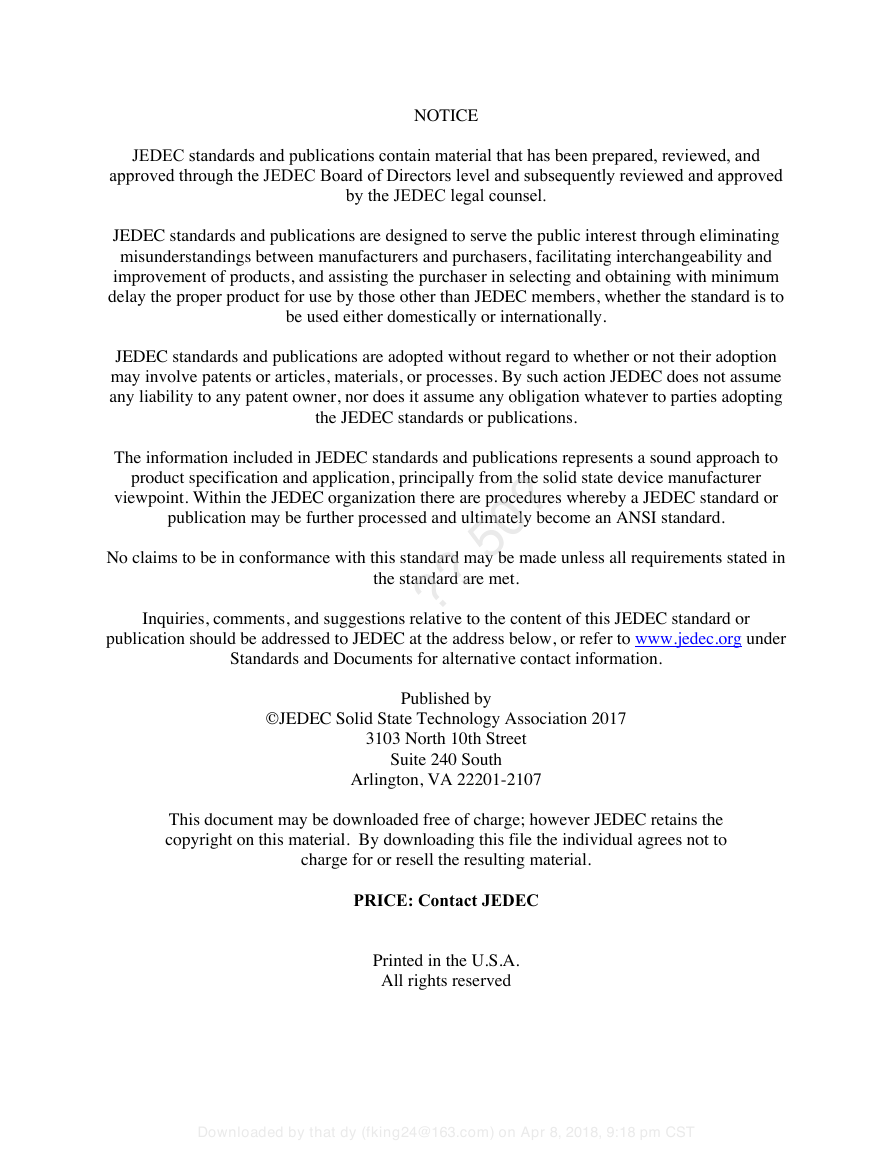
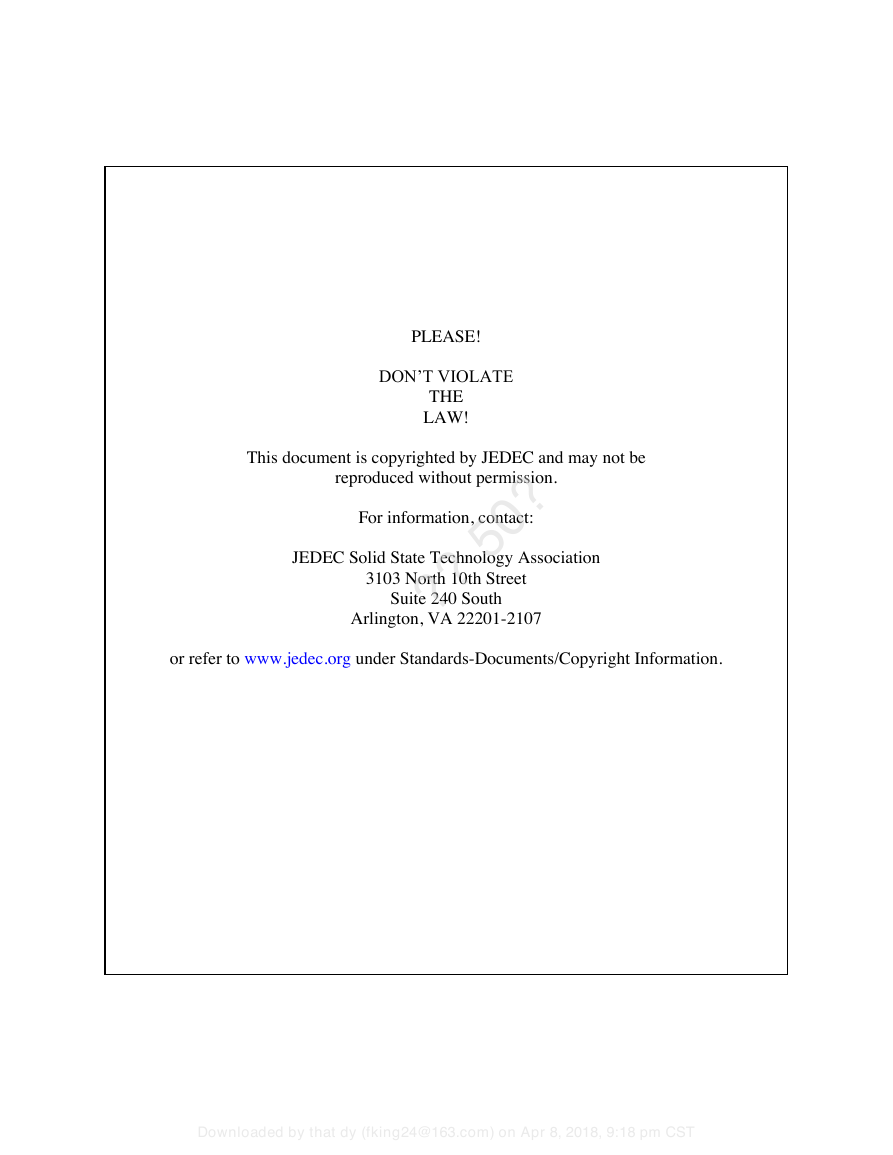

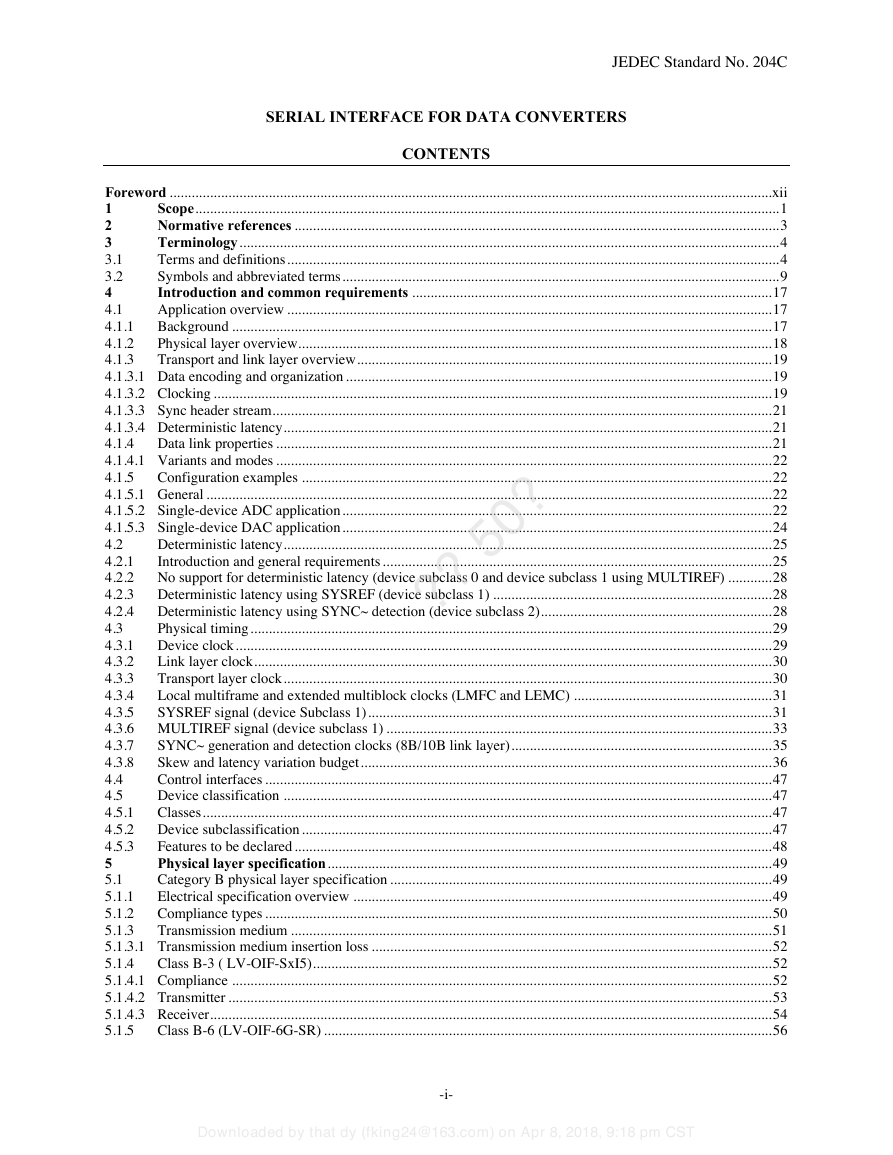
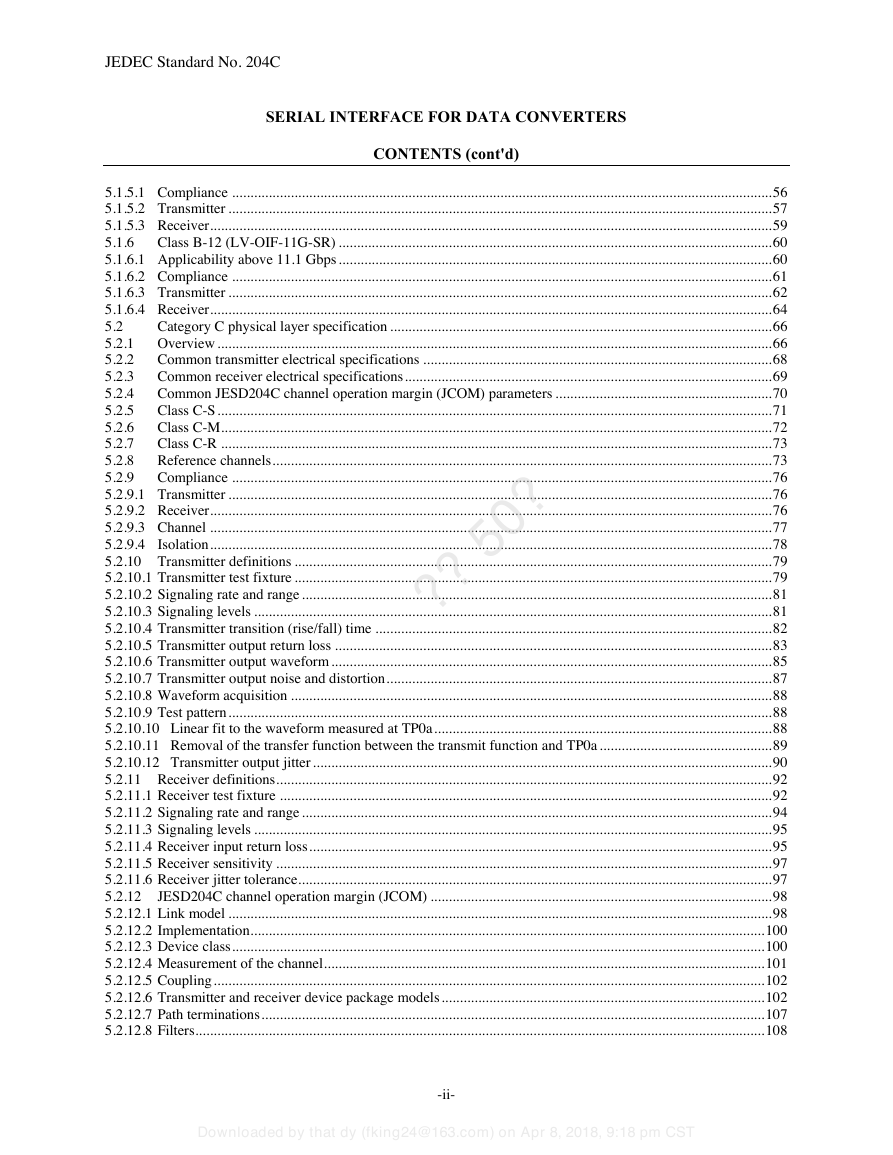
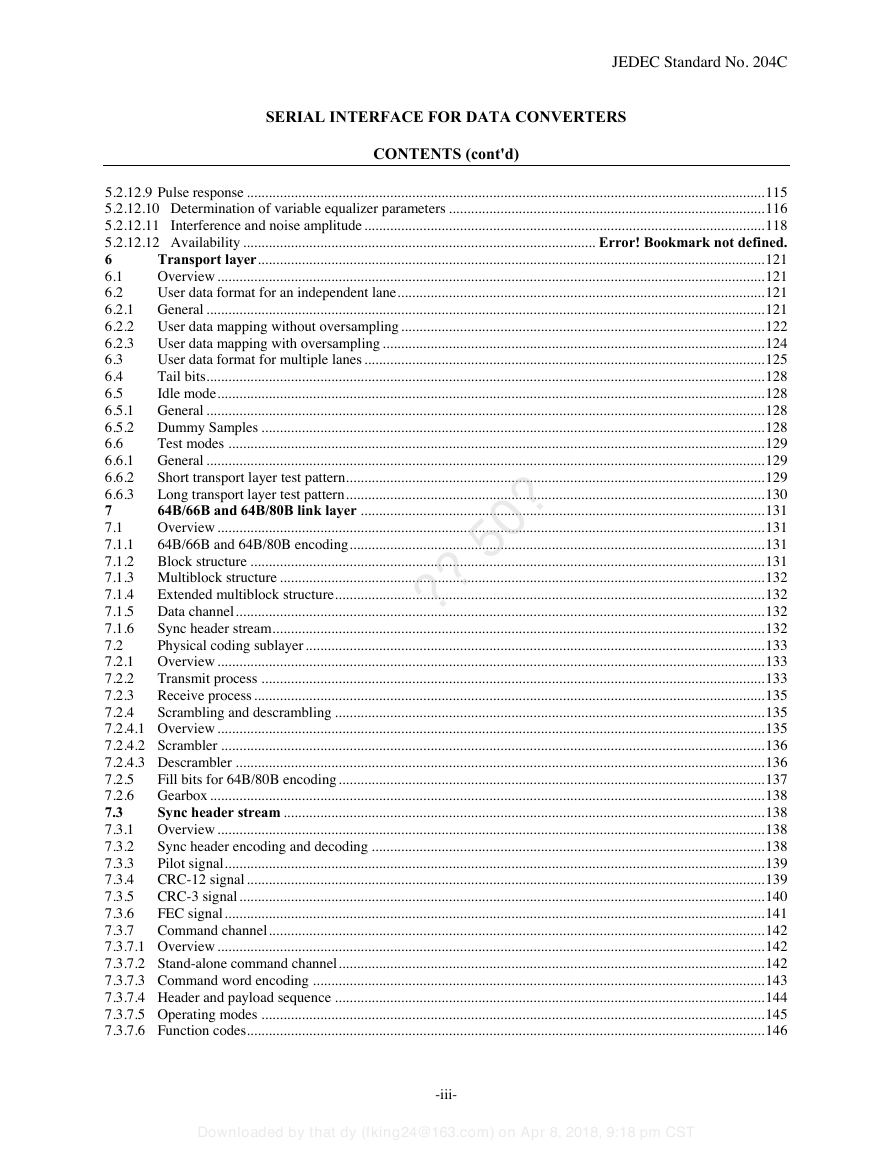
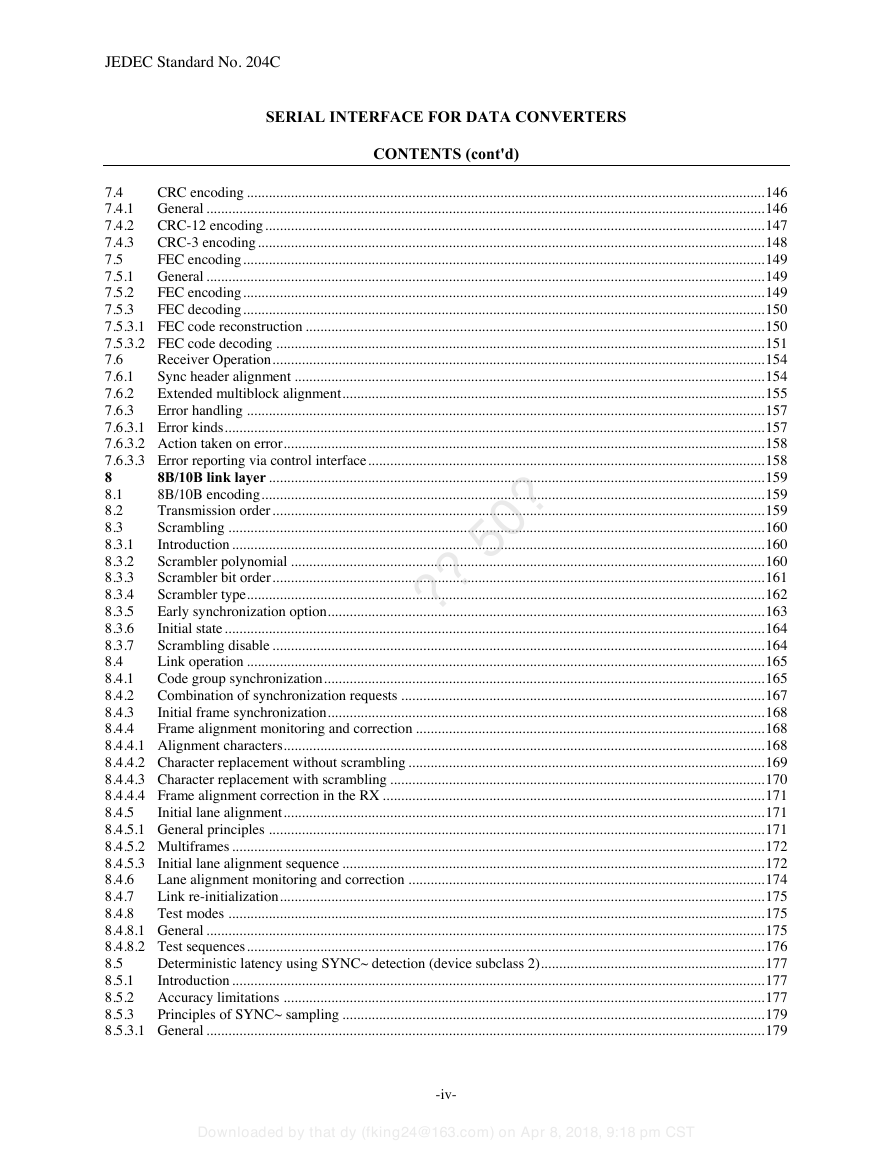








 2023年江西萍乡中考道德与法治真题及答案.doc
2023年江西萍乡中考道德与法治真题及答案.doc 2012年重庆南川中考生物真题及答案.doc
2012年重庆南川中考生物真题及答案.doc 2013年江西师范大学地理学综合及文艺理论基础考研真题.doc
2013年江西师范大学地理学综合及文艺理论基础考研真题.doc 2020年四川甘孜小升初语文真题及答案I卷.doc
2020年四川甘孜小升初语文真题及答案I卷.doc 2020年注册岩土工程师专业基础考试真题及答案.doc
2020年注册岩土工程师专业基础考试真题及答案.doc 2023-2024学年福建省厦门市九年级上学期数学月考试题及答案.doc
2023-2024学年福建省厦门市九年级上学期数学月考试题及答案.doc 2021-2022学年辽宁省沈阳市大东区九年级上学期语文期末试题及答案.doc
2021-2022学年辽宁省沈阳市大东区九年级上学期语文期末试题及答案.doc 2022-2023学年北京东城区初三第一学期物理期末试卷及答案.doc
2022-2023学年北京东城区初三第一学期物理期末试卷及答案.doc 2018上半年江西教师资格初中地理学科知识与教学能力真题及答案.doc
2018上半年江西教师资格初中地理学科知识与教学能力真题及答案.doc 2012年河北国家公务员申论考试真题及答案-省级.doc
2012年河北国家公务员申论考试真题及答案-省级.doc 2020-2021学年江苏省扬州市江都区邵樊片九年级上学期数学第一次质量检测试题及答案.doc
2020-2021学年江苏省扬州市江都区邵樊片九年级上学期数学第一次质量检测试题及答案.doc 2022下半年黑龙江教师资格证中学综合素质真题及答案.doc
2022下半年黑龙江教师资格证中学综合素质真题及答案.doc